



















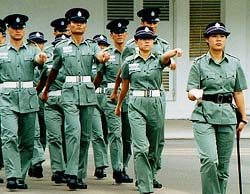 First woman DWI . . . |
POLICE
Training School Probationary Inspectors (PIs) knew they were up for a tough drilling when they
enrolled, but little did they expect their hard-nosed instructor to be a woman.
Don't be fooled by the pretty face, the school's first female Drill and Weapons Instructor (DWI) Senior Inspector Chiang Lai-shan is a no-nonsense trainer, as strict as the guys both in the firing range and the drill square. "I see in Madam Chiang what equality is all about - if you work hard, you are going to succeed regardless of your sex," said PI Lung Siu-chuen. |
|
Though PI Lung and his colleagues in the 464th and 465th Intakes were braced for some hard training
when they enrolled in October last year, they were left gobsmacked when introduced to 'Madam Chiang'.
Since then, the PIs have felt both the 'down to business' wrath of Ms Chiang along with the heartfelt after hours care she also volunteers, two things they believe have sped them through their training. Ms Chiang joined the Force as a Woman Police Constable in 1986, gaining a lot of experience in handling criminal cases. With her top performance, she was promoted to Inspector in 1994 and advanced to Senior Inspector in 1997. "By that time, I wanted to have something different for my career in the Force. I really loved footdrills during my days as an Recruit Police Constable in the Police Training School. The orderly and precise rhythm was simply wonderful and made me long for the chance to give commands myself. | |
|
"So with this, coupled with an intense interest in the use of firearms, I applied to be an instructor at the PTS," Ms Chiang said. However it was a real hard time at the beginning with considerable pressure on the first woman instructor. "It is completely different to be an instructor, you have got so much more to learn. And I appreciate my senior officers for letting me attend special training classes for instructors. My colleagues are all very nice and caring and never fail to help me out," she said. |
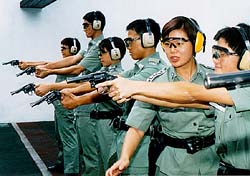 Sweet and Wesson: The kind but tough DWI SIP "Madam" Chiang Lai-shan attends to another batch of recruits in the PTS firing range |
|
And there's little doubt she's taken on her new post with a fervour, giving personal advice to each student, even on the firing range. When it came to using guns, Ms Chiang was an old hand. Back in the days when women police officers were not required to carry guns, she had the courage and enthusiasm to enrol in firearms training which she said was not only out of personal interest, but also for the benefit of her career development. Talk to any PI and they will tell you 'Madam Chiang' is a tough and strict instructor with little compromise. "She's tough but never fails to set a good example of a police officer. However, she's also very caring and would tend to our smallest needs," Woman Probationary Inspector Yiu Kit-yee said. To her students Ms Chiang is a private tutor as well. "She's sacrificed her lunch time have special classes for us and thanks to her help, we're made good progress," PI Lung said. Because of the imminent re-organisation of the PTS's Drill and Weapons Section, Ms Chiang will be its first and last woman instructor, so she and her PIs feel fortunate to have known each other. Despite the sometimes tough exterior, Ms Chiang is bracing for her emotional side to surface during her students' up-coming graduation. "Imagine how happy I will be to see them pass-out in a few weeks," she said. | |
| HIGHLY
-complex examinations can now be conducted at warp-speed with the Force's new-look ballistics unit
which has been technologically revamped.
Over the past four years the Forensic Firearms Examination Bureau has undergone major changes in virtually every aspect of its work, being reborn Phoenix-like into one of the most technologically advanced forensic firearms examination units in the world. Unit head Senior Superintendent Brian Heard said with its top team of scientists, the Bureau has the capability to conduct examinations of a complexity and speed previously only imagined. |
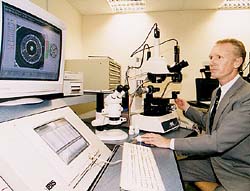 Byte the bullet: SSP Brian Heard at work on the hi-tech forensic equipment linked via computer |
|
"Case examination turn around times are down from months to days, gunshot residue examinations
which previously took three to six months are now available in less than 48 hours, and comparisons
with the Outstanding Crime Index, which previously would have taken two months, can now be
completed in less than an hour," Mr Heard said.
The milestones have been made possible with the acquisition of hi-tech equipment which ranks among the best available. They include two of the most advanced comparison microscopes, the most sophisticated computerised bullet and cartridge case striation comparison units ever, a Scanning Electron Microscope with Energy Dispersive X-Ray Analyser which has automated scanning software specifically tailored to Chinese and Warsaw Pact ammunition, a polychromatic light source for the visualisation of gunsmoke particles on clothing, and a powerful digital image capture system. All of the technical equipment and their relative databases are linked via a sophisticated local area network system through which an officer can access any one of the Bureau's databases or control any of the instruments from his desktop personal computer. A laptop computer can also be used from remote locations. Selected bureaux can access the LAN which will soon allow them to see case reports and statistics for the past 20 years. Mr Heard said the advances to the unit has also led to improvements elsewhere. "The protocols and specifications generated by the Bureau for the evaluation of Bullet Resistant Vests have resulted in the Force having the best general issue vests of any military or police force in the world," he said. "Likewise, the methodology developed for the testing and evaluation of ammunition has resulted in the Force having the most reliable and cost effective ammunition available." Mr Heard said one of the most impressive pieces of equipment was the recently-purchased Integrated Bullet and Cartridge Case Identification System. The tool takes digital images of the scratch marks on fired bullets and cartridge cases which are a gun's equivalent to a person's fingerprints - no two are alike. The digital images are stored in a database and can be compared with those in the Outstanding Crime Index in seconds. The mammoth database facilities allow for the storage of digital images of ammunition held in all the regional forensic laboratories, for the investigation of the cross-border use of guns in armed crime incidents. The database is so big, images from all weapons held by Hong Kong's disciplined forces as well as privately-held weapons can be put on record should one be stolen and used in a crime, allowing for quick and easy identification. Another part of the system includes a portable image collection unit which can be taken to a crime scene where pictures of fired ammunition can be taken and transmitted back to the main facility via mobile phone and modem. The images are automatically processed and compared against the database to see whether the weapon had been used in a crime. "This is a powerful piece of equipment giving the Force access to crime-fighting facilities never before available," Mr Heard said. | |
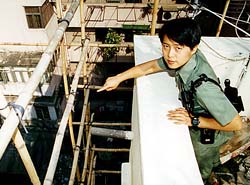 On the edge: WPC Chan at the location of her first day at work |
Woman Police Constable Chan Lan-lin never thought the examinations would continue after graduation, but her first day on the job proved to be the toughest test of them all. Barely out of the Police Training School, the 20-year-old WPC had no hesitation in leaping to the aid of a life which was on the line. Instead of sitting in a briefing room and listening to lectures from senior officers, WPC Chan's first morning of work on May 2 was spent rescuing a suicidal teenager in Tsuen Wan. |
|
She had only graduated from the Police Training School on April 24, being posted to Team 3 of the Patrol Sub-Unit (PSU)
in Tsuen Wan about a week later.
About 8 am that first day, WPC Chan and her colleagues were patrolling in Chung On Street when a young girl was reported to be attempting to jump from a building. "We rushed to the roof of the six-storey building and saw a 14-year-old girl sitting precariously by the edge and looking forward aimlessly," WPC Chan recalled. She then dashed forward and pulled the girl to safety before accompanying her to hospital. "While in the ambulance, the girl told me she had been running away from home and was once sent to a girl's home for her errant behaviour. She was in such a depressed state she wanted to take her own life,Ó the WPC said. The girl was later picked up from hospital by her family, and WPC Chan said the incident was an unforgettable experience for her. "I'd never imagined this would be what I was up for on my first day in the Force. In a situation like that, somebody's life is in your hands and you're got to be very careful. "As green as I was, my Sergeant still trusted me and let me approach the girl. I really appreciate him for giving me a chance to learn something which will definitely be very useful to my future work," she said. | |
|
YOU would never know it by their faces, but Derek Chow, Cheung Kin-kwong or "KK" and Brian Lowcock are triplet brothers, albeit in the mathematical sense. The Kowloon West Regional Headquarters stalwarts were all born on the same day in 1962, but didn't even realise after years of working with each other. The story began in 1988 when KK was then Inspector of the Special Duty Squad in the Mong Kok Police Station. The first time they met was when KK was leaving the post and Derek was assigned as his replacement. |
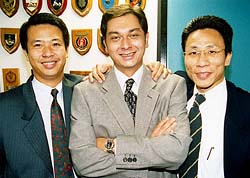 Brothers in arms: Derek, Brian and KK share a laugh at KW RHQ |
|
Both KK and Derek could not remember how they discovered they were born on the same day, but
they got along very well and became close friends.
The uncanny coincidences started flowing again years later in 1997, when they met Brian. He had taken up the post of Chief Inspector of the Kowloon West Regional Crime Unit 1 in 1997, while Derek was the Chief Inspector (Narcotics) and KK the Chief Court Inspector in the same region. Working in the same building, they knew one another through battles on the tennis court and other activities during lunch hours. Brian said he stumbled across Derek's date of birth when they were using their identity cards to book a game of tennis in 1998. It was then that Derek told him that he and KK were also born on the same day. "What makes it even more interesting is when I was seconded to the Narcotics Bureau in April, Derek took up my post as Chief Inspector/Regional Crime Unit 1 while KK, after serving one year in Police Tactical Unit, was posted back to KW Region to become CIP Narcotics!" Brian said. |

![]()
